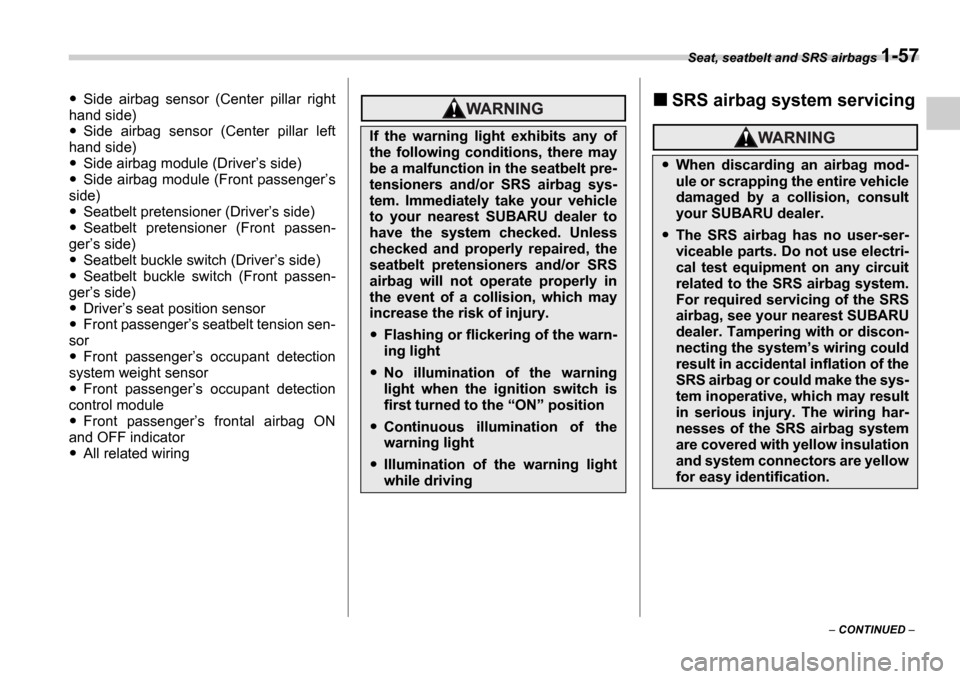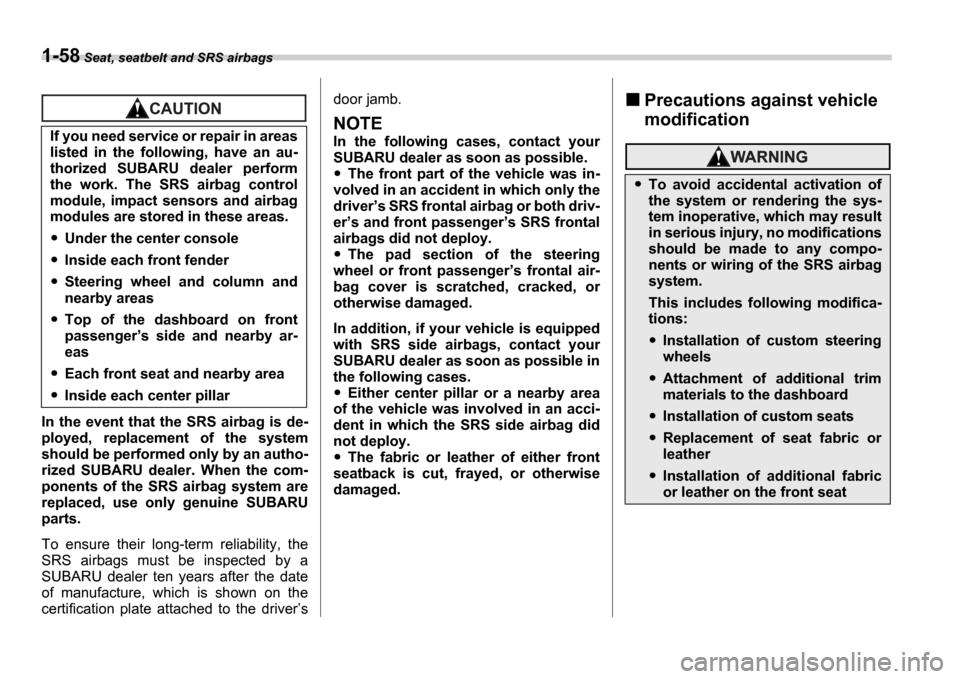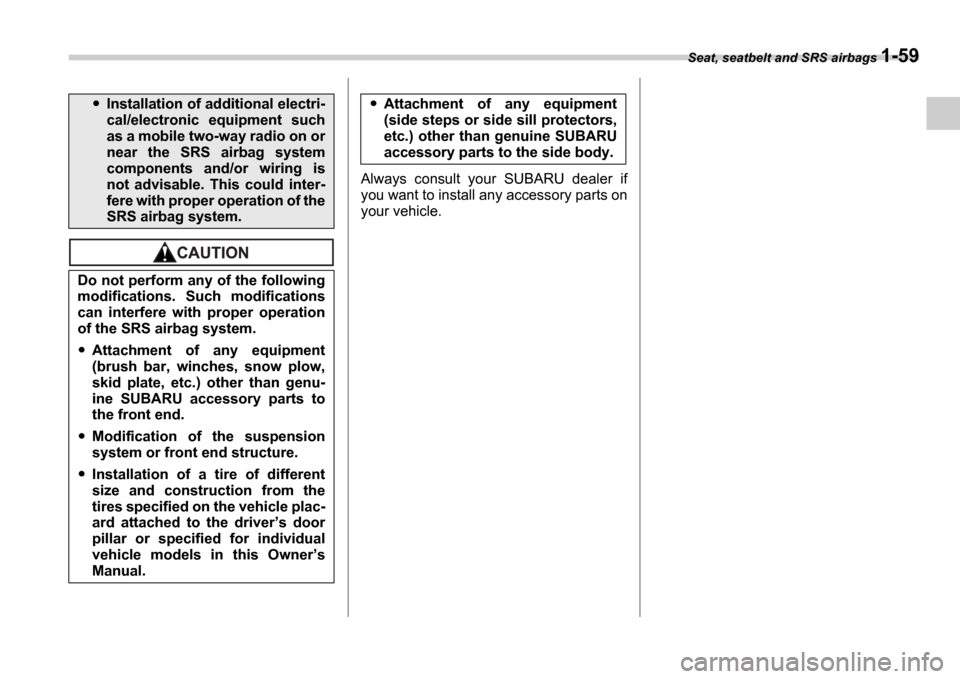2006 SUBARU IMPREZA wiring
[x] Cancel search: wiringPage 48 of 365

Seat, seatbelt and SRS airbags 1-21
CONTINUED
System monitors
A diagnostic system continually monitors
the readiness of the seatbelt pretensioner
while the vehicle is being driven. The seat-
belt pretensioners share the control mod-
ule with the SRS airbag system. There-
fore, if any malfunction occurs in a seat-
belt pretensioner, the SRS airbag system
warning light will illuminate. The SRS air-
bag system warning light will show normal
system operation by lighting for approxi-
mately 6 seconds when the ignition switch is turned to the
ON position.
The following components are monitored
by the indicator:
Front sub sensor (Right-hand side)
Front sub sensor (Left-hand side)
Airbag control module (including impact
sensors)
Frontal airbag module (Driver s side)
Frontal airbag module (Front passen-
ger s side)
Side airbag sensor (Center pillar right
hand side)
Side airbag sensor (Center pillar left
hand side)
Side airbag module (Driver s side)
Side airbag module (Front passenger s
side)
Seatbelt pretensioner (Driver s side)
Seatbelt pretensioner (Front passen-
ger s side)
Seatbelt buckle switch (Driver s side)
Seatbelt buckle switch (Front passen-
ger s side)
Driver s seat position sensor
Front passenger s seatbelt tension sen-
sor
Front passenger s occupant detection
system weight sensor
Front passenger s occupant detection
control module
Front passenger s frontal airbag ON
and OFF indicator
All related wiringWhen discarding front seatbelt re-
tractor assemblies or scrapping
the entire vehicle due to collision
damage or for other reasons, con-
sult your SUBARU dealer.
100291
If the warning light exhibits any of
the following conditions, there may
be a malfunction in the seatbelt pre-
tensioners and/or SRS airbag sys-
tem. Immediately take your vehicle
to your nearest SUBARU dealer to
have the system checked. Unless
checked and properly repaired, the
seatbelt pretensioners and/or SRS
airbag will not operate properly in
the event of a collision, which may
increase the risk of injury.
Flashing or flickering of the indi-
cator light
No illumination of the warning
light when the ignition switch is
first turned to the ON position
Continuous illumination of the
warning light
Illumination of the warning light
while driving
Page 49 of 365

1-22 Seat, seatbelt and SRS airbags
System servicing
NOTE
If the front part of the vehicle is dam-
aged in an accident to the extent that
the seatbelt pretensioner does not op-
erate, contact your SUBARU dealer as
soon as possible.
Precautions against vehicle
modification
Always consult your SUBARU dealer if
you want to install any accessory parts to
your vehicle.
When discarding a seatbelt retrac-
tor assembly or scrapping the en-
tire vehicle damaged by a colli-
sion, consult your SUBARU deal-
er.
Tampering with or disconnecting
the system s wiring could result in
accidental activation of the seat-
belt pretensioner and/or SRS air-
bag or could make the system in-
operative, which may result in se-
rious injury. The wiring harnesses
of the seatbelt pretensioner and
SRS airbag systems are covered
with yellow insulation and the
connectors of the system are yel-
low for easy identification. Do not
use electrical test equipment on
any circuit related to the seatbelt
pretensioner and SRS airbag sys-
tems. For required servicing of
the seatbelt pretensioner, see
your nearest SUBARU dealer.
The front sub sensors are located in
both front fenders and the SRS air-
bag control module including the
impact sensors is located under the
center console. If you need service
or repair in those areas or near the
front seatbelt retractors, we recom-
mend that you have an authorized
SUBARU dealer perform the work.
Do not perform any of the following
modifications. Such modifications
can interfere with proper operation
of the seatbelt pretensioners.
Attachment of any equipment
(bush bar, winches, snow plow,
skid plate, etc.) other than genu-
ine SUBARU accessory parts to
the front end.
Modification of the suspension
system or front end structure.
Installation of a tire of different
size and construction from the
tires specified on the vehicle plac-
ard attached to the driver s door
pillar or specified for individual
vehicle models in this Owner s
Manual.
Page 65 of 365

1-38 Seat, seatbelt and SRS airbags
Components
1
2
3
4
5
6
14 15
2019
8
11 17
18
9
7 10
12
16
13
100701 1) Airbag control module (including impact
sensors)
2) Frontal airbag module (driver s side)
3) Frontal airbag module (front passen-
gers side)
4) Front sub sensor (left-hand side)
5) Front sub sensor (right-hand side)
6) Side airbag module (driver s side)
7) Side airbag module (front passenger s
side)
8) Side airbag sensor (center pillar left-
hand side)
9) Side airbag sensor (center pillar right- hand side)
10)Airbag wiring (yellow)
11)Seatbelt pretensioner (driver s side)
12) Seatbelt pretensioner (front passenger s
side)
13)Seatbelt buckle switch (front passen- gers side)
14)Seatbelt buckle switch (driver s side)
15) Driver s seat position sensor
16)Front passenger s seatbelt tension sen-
sor
17)Front passenger s occupant detection
system weight sensor
18)Front passenger s occupant detection
control module
19)Front passenger s frontal airbag ON and
OFF indicator
20)SRS airbag system warning light
Page 84 of 365

Seat, seatbelt and SRS airbags 1-57
CONTINUED
Side airbag sensor (Center pillar right
hand side)
Side airbag sensor (Center pillar left
hand side)
Side airbag module (Driver s side)
Side airbag module (Front passenger s
side)
Seatbelt pretensioner (Driver s side)
Seatbelt pretensioner (Front passen-
ger s side)
Seatbelt buckle switch (Driver s side)
Seatbelt buckle switch (Front passen-
ger s side)
Driver s seat position sensor
Front passenger s seatbelt tension sen-
sor
Front passenger s occupant detection
system weight sensor
Front passenger s occupant detection
control module
Front passenger s frontal airbag ON
and OFF indicator
All related wiring
SRS airbag system servicing
If the warning light exhibits any of
the following conditions, there may
be a malfunction in the seatbelt pre-
tensioners and/or SRS airbag sys-
tem. Immediately take your vehicle
to your nearest SUBARU dealer to
have the system checked. Unless
checked and properly repaired, the
seatbelt pretensioners and/or SRS
airbag will not operate properly in
the event of a collision, which may
increase the risk of injury.
Flashing or flickering of the warn-
ing light
No illumination of the warning
light when the ignition switch is
first turned to the ON position
Continuous illumination of the
warning light
Illumination of the warning light
while driving
When discarding an airbag mod-
ule or scrapping the entire vehicle
damaged by a collision, consult
your SUBARU dealer.
The SRS airbag has no user-ser-
viceable parts. Do not use electri-
cal test equipment on any circuit
related to the SRS airbag system.
For required servicing of the SRS
airbag, see your nearest SUBARU
dealer. Tampering with or discon-
necting the system s wiring could
result in accidental inflation of the
SRS airbag or could make the sys-
tem inoperative, which may result
in serious injury. The wiring har-
nesses of the SRS airbag system
are covered with yellow insulation
and system connectors are yellow
for easy identification.
Page 85 of 365

1-58 Seat, seatbelt and SRS airbags
In the event that the SRS airbag is de-
ployed, replacement of the system
should be performed only by an autho-
rized SUBARU dealer. When the com-
ponents of the SRS airbag system are
replaced, use only genuine SUBARU
parts.
To ensure their long-term reliability, the
SRS airbags must be inspected by a
SUBARU dealer ten years after the date
of manufacture, which is shown on the
certification plate attached to the driver s door jamb.
NOTE
In the following cases, contact your
SUBARU dealer as soon as possible.
The front part of the vehicle was in-
volved in an accident in which only the
driver s SRS frontal airbag or both driv-
er s and front passenger s SRS frontal
airbags did not deploy.
The pad section of the steering
wheel or front passenger s frontal air-
bag cover is scratched, cracked, or
otherwise damaged.
In addition, if your vehicle is equipped
with SRS side airbags, contact your
SUBARU dealer as soon as possible in
the following cases.
Either center pillar or a nearby area
of the vehicle was involved in an acci-
dent in which the SRS side airbag did
not deploy.
The fabric or leather of either front
seatback is cut, frayed, or otherwise
damaged.
Precautions against vehicle
modification
If you need service or repair in areas
listed in the following, have an au-
thorized SUBARU dealer perform
the work. The SRS airbag control
module, impact sensors and airbag
modules are stored in these areas.
Under the center console
Inside each front fender
Steering wheel and column and
nearby areas
Top of the dashboard on front
passenger s side and nearby ar-
eas
Each front seat and nearby area
Inside each center pillar
To avoid accidental activation of
the system or rendering the sys-
tem inoperative, which may result
in serious injury, no modifications
should be made to any compo-
nents or wiring of the SRS airbag
system.
This includes following modifica-
tions:
Installation of custom steering
wheels
Attachment of additional trim
materials to the dashboard
Installation of custom seats
Replacement of seat fabric or
leather
Installation of additional fabric
or leather on the front seat
Page 86 of 365

Seat, seatbelt and SRS airbags 1-59
Always consult your SUBARU dealer if
you want to install any accessory parts on
your vehicle.
Installation of additional electri-
cal/electronic equipment such
as a mobile two-way radio on or
near the SRS airbag system
components and/or wiring is
not advisable. This could inter-
fere with proper operation of the
SRS airbag system.
Do not perform any of the following
modifications. Such modifications
can interfere with proper operation
of the SRS airbag system.
Attachment of any equipment
(brush bar, winches, snow plow,
skid plate, etc.) other than genu-
ine SUBARU accessory parts to
the front end.
Modification of the suspension
system or front end structure.
Installation of a tire of different
size and construction from the
tires specified on the vehicle plac-
ard attached to the driver s door
pillar or specified for individual
vehicle models in this Owner s
Manual.
Attachment of any equipment
(side steps or side sill protectors,
etc.) other than genuine SUBARU
accessory parts to the side body.
Page 283 of 365

11-4 Maintenance and service
Before checking or servicing
in the engine compartment
When you do checking or ser-
vicing in the engine compart-
ment while the engine is run-
ning
Engine hood
0
To open the hood:
1. If the wiper blades are lifted off the
windshield, return them to their original
positions.
2. Pull the hood release knob under the
instrument panel.
Wear adequate eye protection to
guard against getting oil or fluids
in your eyes. If something does
get in your eyes, thoroughly wash
them out with clean water.
Do not tamper with the wiring of
the SRS airbag system or seatbelt
pretensioner system, or attempt
to take its connectors apart, as
that may activate the system or it
can render it inoperative. The wir-
ing and connectors of these sys-
tems are yellow for easy identifi-
cation. NEVER use a circuit tester
for these wiring.
If your SRS airbag or seatbelt pre-
tensioner needs service, consult
your nearest SUBARU dealer.
Always stop the engine and set
the parking brake firmly to pre-
vent the vehicle from moving.
Always let the engine cool down.
Engine parts become very hot
when the engine is running and
remain hot for some time after the
engine is stopped.
Do not spill engine oil, engine
coolant, brake fluid or any other
fluid on hot engine components.
This may cause a fire.
Always remove the key from the
ignition switch. When the ignition
switch is in the ON position, the
cooling fan may operate suddenly
even when the engine is stopped.
A running engine can be dangerous.
Keep your fingers, hands, clothing,
hair and tools away from the cooling
fan, belts and any other moving en-
gine parts. Removing rings, watch-
es and ties is advisable.
B00002
Page 320 of 365

Maintenance and service 11-41
CONTINUED
1) Cap
2) Upper level
3) Lower level
It is unnecessary to periodically check the
battery fluid level or periodically refill with
distilled water.
However, if the battery fluid level is below
the lower level, remove the cap. Fill to the
upper level with distilled water.
Fuses
The fuses are designed to melt during an
overload to prevent damage to the wiring
harness and electrical equipment. The
fuses are located in two fuse boxes.
One is located under the instrument panel
behind the coin tray on the driver s seat
side.
To lessen the risk of sparks, re-
move rings, metal watchbands,
and other metal jewelry. Never al-
low metal tools to contact the pos-
itive battery terminal and anything
connected to it WHILE you are at
the same time in contact with any
other metallic portion of the vehi-
cle because a short circuit will re-
sult.
Keep everyone including children
away from the battery.
Charge the battery in a well-venti-
lated area.
Battery posts, terminals and relat-
ed accessories contain lead and
lead compounds, chemicals
known to the State of California to
cause cancer and reproductive
harm. Batteries also contain other
chemicals known to the State of
California to cause cancer. Wash
hands after handling .
Never use more than 10 amperes
when charging the battery because
it will shorten battery life.
1
2 3
B00382
Never replace a fuse with one hav-
ing a higher rating or with material
other than a fuse because serious
damage or a fire could result.
B00172